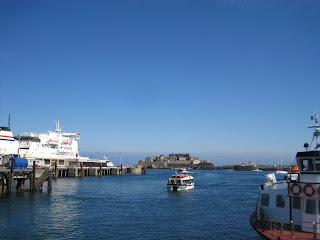



Our stop in Tallinn was one of our favourite tours of the entire trip! We didn't really know much about Estonia so we weren't quite sure what to expect on our walking tour of the Old Town. As our guide explained to us, Tallinn is one of the best preserved medieval towns in Europe with many of the original walls and turrets still standing and in excellent condition. Our bus dropped us off at the top of Toompea Hill where we began our tour by strolling through the lovely gardens adjacent to the old Estonian royal palace, which is now the Parliament building. Painted pink and white, it is not what usually comes to mind when one thinks of the seat of government! We then made our way across the square to the beautiful Alexander Nevsky Cathedral, a Russian Orthodox Church. Its numerous onion domes were imposing, but the inside was even more magnificent with the gilded decorations and icons, beautiful religious paintings on the walls and ceiling, and the stunning blue dome decorated with hundreds of golden stars. Unfortunately we were not able to take any photographs inside, so you'll just have to use your imagination! Our guide next led us down cobblestone streets past women selling spiced almonds and pecans from small stalls to an overlook from which we were treated to a panoramic view of the city and the harbour below. We then visited the oldest church in Tallinn, a Lutheran church which was built by the Danes in the 13th Century. It is so old that the foundations have sunk and you have to walk down a series of stairs to reach the main floor! The walls are covered with wooden coats of arms of the families that worshipped there, and the individual pews are enclosed in wooden boxes with a gate-like door at the end through which the family would enter – mum was particularly fascinated by this set-up! We continued our journey down the steep and narrow Short Leg Street to yet another church. Turned into a storage room under Communist rule, it has recently been restored and is now used as a museum and concert hall. Inside we were treated to a wonderful concert of medieval music, complete with period costumes and original instruments. The singer had the voice of an angel, and of course the acoustics in the church were marvellous! The church contained some interesting sculptures and paintings including a fragment of a large 15th century painting of the Danse Macabre complete with portraits of important people of the time in which it was produced. Our final stop of the day was at the town square which is surrounded by buildings that have been there for at least 500 years. As luck would have it we were there on a Wednesday which is the day that they have an open-air market set up in medieval style. There was medieval music playing in the background, and many of the stall-holders were dressed up in medieval costumes, including a couple of jesters leaping around in the background. Mum and I enjoyed investigating the stalls of hand-embroidered linens, carved wooden utensils, knitted goods, furs, wild and wonderful hats and various souvenirs. After parting with some of our Euros (only too happily I might add!) we found a shady spot on some stone steps and enjoyed watching the spectacle before us until it was time to rejoin our group for the return trip to the pier.











































